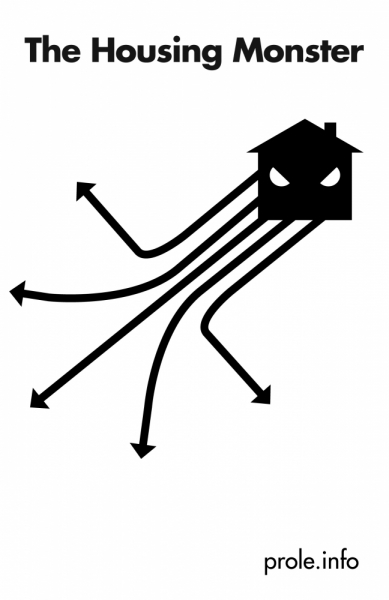(This review of The Housing Monster by Prole.info first appeared in Anarchist Studies, Vol. 22, No 1. January 2014)
– – –
 Anarchists have been wrestling with the politics of the built environment since the middle of the twentieth century, if not earlier. John F. C. Turner wrote influential books on architecture, Colin Ward put out worthy studies of housing and urbanism, and there is a small shelf of anarchist-inspired works on squats. These are the most conspicuous examples, but there are many others.
Anarchists have been wrestling with the politics of the built environment since the middle of the twentieth century, if not earlier. John F. C. Turner wrote influential books on architecture, Colin Ward put out worthy studies of housing and urbanism, and there is a small shelf of anarchist-inspired works on squats. These are the most conspicuous examples, but there are many others.
The Housing Monster is part of this tradition. Authored by someone (or some people) identified only as ‘prole.info’, this short, pamphlet-like work uses something that we typically take for granted—the house—as a springboard for a critical meditation on capitalist society as a whole. ‘A house is more than four walls and a roof ’, writes prole.info. ‘From its design and production to the way it is sold, used, resold and eventually demolished, it is crisscrossed by conflict. From the construction site to the neighbourhood, impersonal economic forces and very personal conflicts grow out of each other.’(p 4)
The goal of The Housing Monster is to unpack and clarify these conflicts and show how their resolution requires a revolutionary transformation of the social context that produces them. Modeled loosely on Marx’s analysis of the commodity in Capital, it begins with a discussion of the home as a physical fact, which leads to a discussion of the construction industry and construction work, which leads to a consideration of neighbourhoods and urban planning, which leads to an excursus on attempts at housing alternatives, which leads, finally, to a call to abandon reform and abolish capitalism as a whole. For prole.info, serious reflection on housing pushes us to think beyond the present society.
The Housing Monster operates at a high level of generality and abstraction. Filled with dramatic, black-and-white illustrations and cast in an intimate tone, it intends to explore the intersection of housing, capitalism, and the state as such, not these things in specific geographic or historical contexts. This is a weakness to the degree that prole.info has a tendency to skate over important particulars. Surely housing is different in Bombay and Montreal and New Haven and surely it was different in 1914 as compared to today. Some recognition of these differences would have improved the text.
But the book’s sweeping quality is also a strength. Indeed, what makes it unique is not so much its commentary on specific aspects of housing as its ability to portray it as a vast social process in which capital, labour, and politics interact at various registers and in various hues. It is a dialectical, highly relational work that gestures toward a conflicted, complicated totality of social relations and invites activists to place their work in that context. The implication is that doing so will enable them to ‘relate to each other in new ways … discover abilities we didn’t know we had, and … begin to feel our power’. (p 143)
Th is genre-bending book is probably too zine-like for housing scholars and too scholarly for casual readers. Nonetheless, it is inspired and compelling and carries on the tradition of anti-authoritarian interrogation of the built environment. It does so by reminding us of something that Turner, Ward and others have articulated in their own terms over the years: houses are much more than structures, they are also sites of social struggle and potentially arenas for the assertion of revolutionary aspirations.
~ Chuck Morse
Prole.info, The Housing Monster Oakland, CA: PM Press, 2012, 1 47 pp; ISBN-13: 978-1-604865-30-1.
